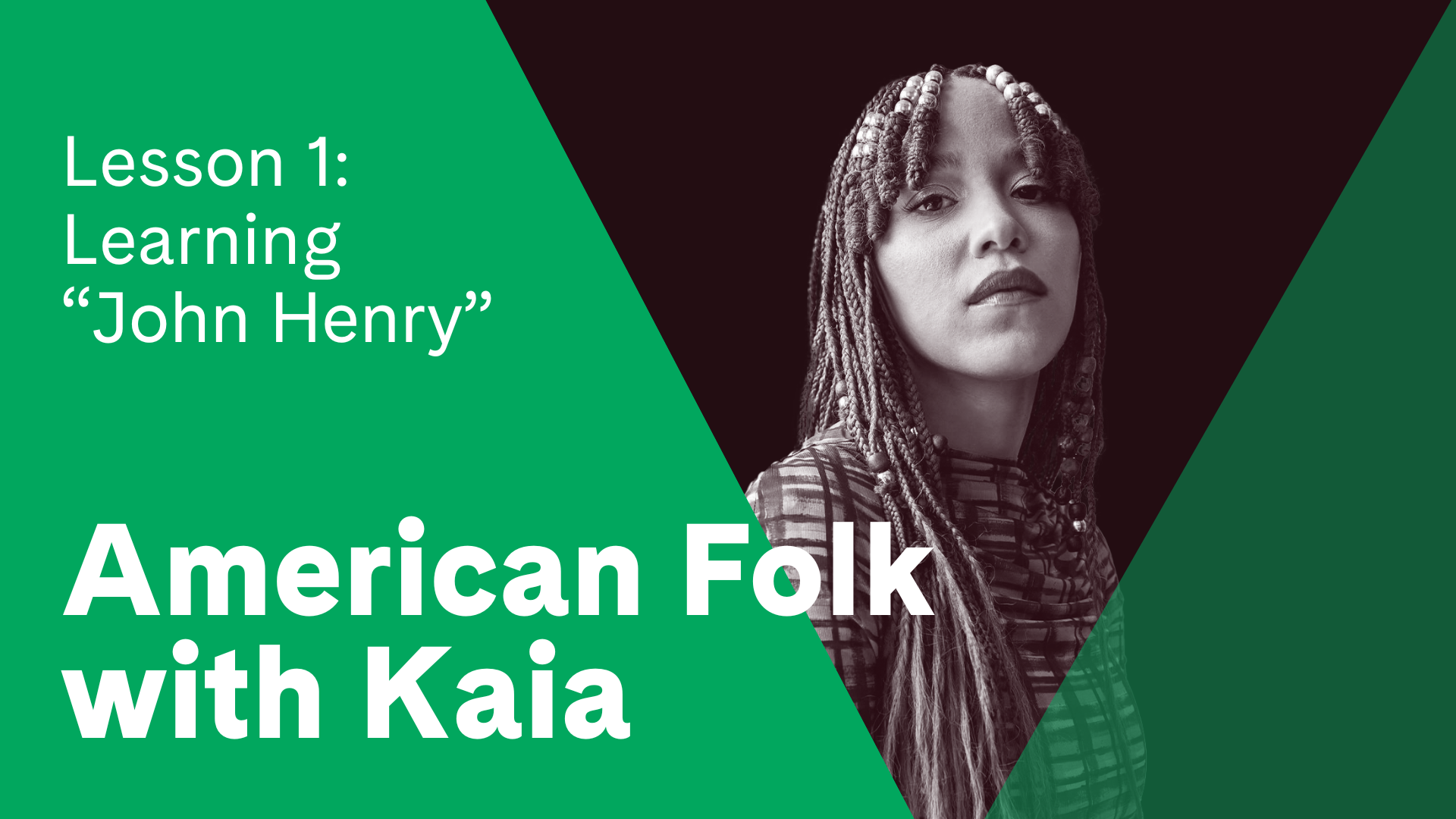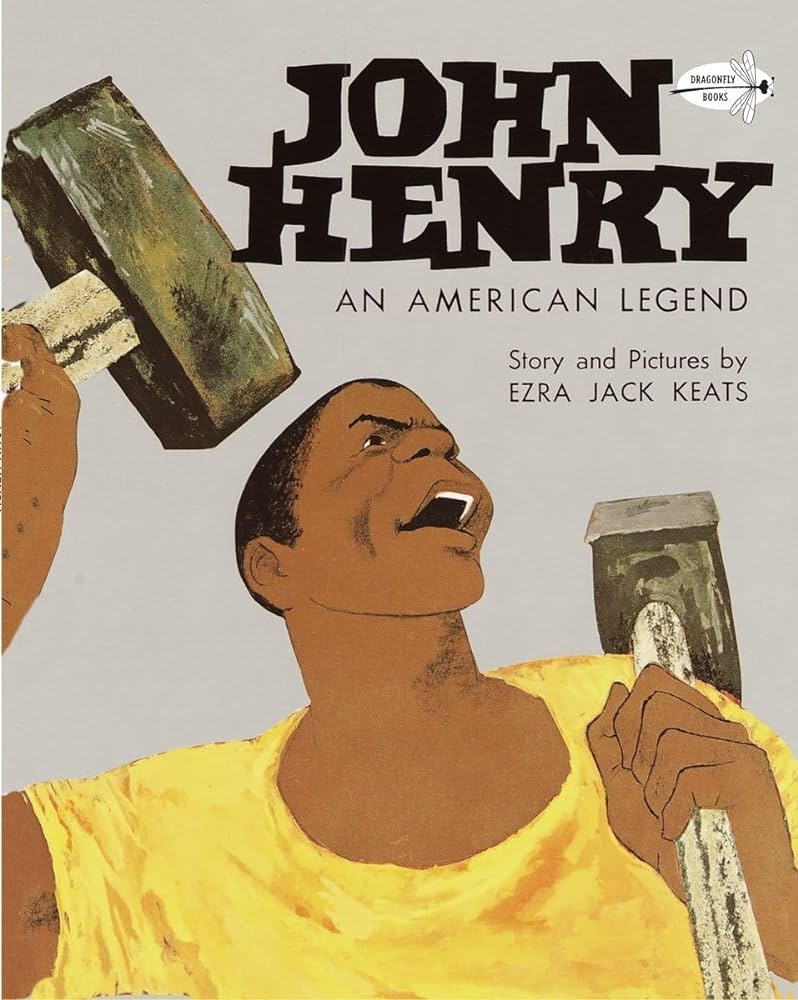Aim: How can we understand how music tells a story while learning to sing the folk song “John Henry?”
Summary: Students learn and sing “John Henry” while understanding how music can be used totell a story.
Materials: Musical Explorers online audio
Standards: GA: MK-2GM.1, MK-2GM.6, MK-2GM.7, MK-2GM.9, MK-2GM.10 SC: GM.PR.NL-AH.3, GM.RE.NL-AH.6, GM.RE.NL-AH.7, GM.CN.NL-AH.8, GM.CN.NL-AH.9
Vocabulary: ballad, folk tale, lyrics, oral tradition, steady beat
Sing “John Henry”
- Listen to Kaia sing the song “John Henry,” Track 1.1. “John Henry” is a type of song called a ballad. A ballad is a story that is set to music.
- Ask students to pay attention to the words of the song. Do they notice Kaia repeating anything?
- Kaia repeats the last phrase of every verse. Listen to Kaia and sing with her when she repeats a phrase.
Track 1.1 – “John Henry” Song

Oral Tradition and Folk Music
Folk musicians often learn songs from other people in their family or community. This is called an oral tradition. The songs are passed down from generation to generation and are learned “by ear.” Often, these songs are so old that we don’t know who originally wrote the song. Ask students if they have learned any songs from someone in their family or community. Discuss as a class to connect their experiences to the meaning of oral tradition. What makes it folk music?
“John Henry” is based on a folk tale. A folk tale is a story that is passed down through oral tradition. Just like folk music, it is passed from generation to generation. John Henry was an African-American folk hero who was famous for hammering steel to construct a railroad tunnel. He was placed in a contest against a steam-powered hammer and he won!
“John Henry”
When John Henry was a little baby, he was sitting on his papa’s knee.
He picked up a hammer and a little piece of steel;
Saying, “Hammer’s gonna be the death of me, Lord, Lord.
Response:
Hammer’s gonna be the death of me
Hammer’s gonna be the death of me.”
The captain said to John Henry
“I’m gonna bring that steam drill around.
Gonna bring that steam drill out on the job.
Gonna whip that steel on down, down, down.
Response:
Whip that steel on down.
Whip that steel on down.”
John Henry told his captain,
“A man ain’t nothin’ but a man,
But before I let your steam drill beat me down,
I’d die with a hammer in my hand, hand, hand.
Response:
I’d die with a hammer in my hand
I would die with a hammer in my hand.”
Now the man that invented the steam drill
He thought he was mighty fine,
But John Henry made fifteen feet;
The steam drill only made nine.
Response:
That steam drill only made nine.
John Henry hammered in the mountain
And his hammer was striking fire.
He worked so hard, he broke his poor heart.
And he laid down his hammer and he died.
Response:
He laid down his hammer and he died.
John Henry had a little woman.
Her name was Polly Ann.
When John Henry got sick and went to his bed.
Polly Ann drove steel like a man.
Response:
Polly Ann drove steel like a man.
Well, every Monday morning
When the bluebirds start to sing.
You can hear John Henry for a mile or more.
You can hear John Henry’s hammer ring.
Response:
You can hear John Henry’s hammer ring.
You can hear John Henry’s hammer ring.
Explore the Lyrics in “John Henry”
- Lyrics are the words to a song.
- How do the lyrics help to tell John Henry’s story?
- Using the graphic organizer on SG 9, use words and pictures to summarize the folk tale of John Henry.
Explore Steady Beat in “John Henry”
- Listen to John Henry again. Ask students to clap their hands or tap their legs as they listen to the song. Explain to students that the steady pulse they feel in music is the steady beat.
- Ask students if they can find the steady beat in “John Henry.”
- Using rhythm sticks or pencils, tap the steady beat. You can further explore steady beat by discussing how a steel driver like John Henry would have kept a steady beat while hammering steel. Students can even pretend that the sound of the pencils/rhythm sticks are hammers.
Track 1.1 – “John Henry” Song
Literacy Link: John Henry: An American Legend
Creative Extension: Write Your Own Tall Folk Tale
Tall tales are a part of American folk literature. The tales and songs they inspired were often sung around a campfire at the end of long, hard work days. They were orally passed along and changed depending on who was telling or singing the story. The instruments that accompanied them were string instruments that could be easily transported to where the work was, such as banjo, fiddle, and guitar. The song “John Henry” is based on a real person(s), but has exaggerated ideas along with factual ones. The people featured in tall tales often become larger than life with unbelievable elements mixed with facts. As a class or individually, use SG 10 to write a tall tale.
- Who is your main character?
- What does your character look like?
- What is the problem in the story? What is the solution?
- Describe your character.
- What are the ideas/traits that you can exaggerate?
Sing More Folk Songs!
Many traditional children’s songs are folk songs, including “Froggy Went A-Courtin’,” “She’ll be Comin’ Round the Mountain,” “The Bear Went Over the Mountain,” “I’ve Been Working on the Railroad,” and “Oh Susanna.” Like Kaia’s songs in this unit, many of the songs come from West Virginia and have similar themes, including mountains, railroads, and working.
Musical Word Wall
Add ballad, folk tale, lyrics, oral tradition, and steady beat to the Musical Word Wall.
Audio Tracks
Track 1.1 – “John Henry” Song
← Previous: Unit 1 – American Folk with Kaia


